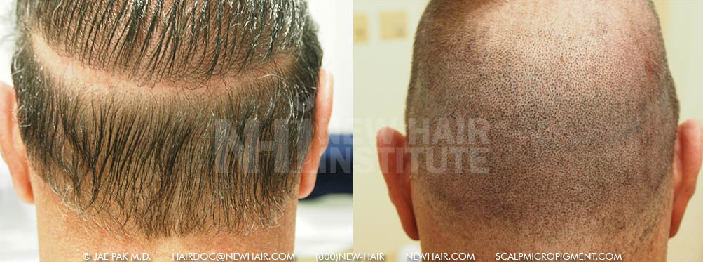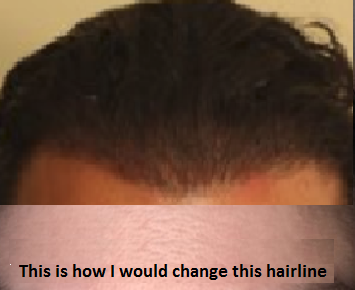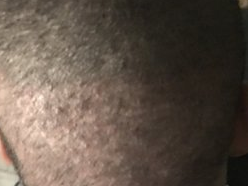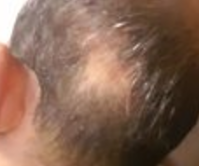The best treatment for scalp scars is Scalp MicroPigmentation. I have extensively published on this technique and on the website you can see many examples of patients who had this done for scars of all types. Below is a typical example of a patient who had a scalp scar treated with Scalp Micropigmentation and you can see more examples of this here: https://scalpmicropigmentation.com/scar-covering/
https://www.hairlosstalk.com/interact/threads/latest-patents-from-dr-george-cotsarelis.108549/
I had a surgery some years ago for gynecomastia and am now considering a hair transplant. The doctor tells me that if I take Finasteride, I can prevent shock hair loss. Will this cause my gynecomastia to return?
If you had Gynecomastia (breast lumps or breast enlargement in men) from a non-Finasteride related cause, then taking the drug should not produce a recurrence of the problem for you even at traditional doses and your risk for developing it is about the same as anyone who never hair gynecomastia with finasteride.
My hair was transplanted and I think it looks bad. What do you think?
I think that your hairline is too high and far too harsh and abrupt. You can actually see the hairline abruptly start from your forehead with no softness present. You can draw a line where your hairline is, I always talk about an undetectable hairline and the way you know if your hairline is completely normal is that nobody looks at your hairline when they speak with you. I tell my patient that if ever anyone stares at their hairline or comment about how nice the transplant looks, my work would be a failure. You are actually in a good situation as the hairline is so high that a new hairline can be created in the normal position and bury the hairline you have so that no one will ever see it. Just get a good hair transplant surgeon who will build a normal hairline lower than the one you received just like the photo on the right which is superimposed upon your photo.
Drs. Nilofer, Bessem Farjo and Paul Kemp wrote an article for the Hair Transplant Forum in this past issue discussing an innovative approach to hair “cloning”. For years (as early as 1991) the anticipation of breakthroughs in hair cloning has been on the horizon, ‘always within the next 5 years’. But every half decade, another 5 years went by and still the promise continued that hair cloning would be available ‘within the next 5 years’. My usual comment was that when the actual breakthrough would become available by scientists and researchers, the FDA process would add another 10-15 years of testing required to bring hair cloning to the commercial marketplace. Relevant to this writing, you should know that doctors have certain powers with regard to administering patient care. They can formulate drug (without FDA approval) under their medical license and many doctors have done just this, coming up with treatments for hair loss with medications that may or may not work. The FDA has no overview of their activities, only the licensing agencies by the governments that license these doctor. But moving into the hair cloning area was tricky. Some doctors have been supplying hair stem cells, most of them scammers who were ripping off their patients for many $$. Some have even done this on a large scale.
Then Drs. Nilofer, Bessem Farjo and Paul Kemp came up with a very cleaver approach that would bypass the FDA once breakthroughs were available. They would ‘Bank’ a patient’s own hair just like eggs from ovaries or sperm is banked. With these banked hair cells, once a breakthrough was made, they could use these Banked hair cells as a source for hair replication, cloning or any other similar breakthrough. By returning products made from ‘Banked cells’ back to the patients who donated the Banked cells, it fell within the practice of medicine and completely bypassed the FDA channels. So breakthroughs for individual patients can be made available to the patients who supplied the Banked hair cells. Of course, it is critical to have ethical doctors here, and in this case it is hard to get better more reputable doctors than Drs. Nilofer, Bessem Farjo and Paul Kemp. They then turned their attention to some of the breakthrough technologies like Intercytex Corporation that lost funding in years past when they were hot on a solution for hair cloning. The parent company, Aderans, which acquired the intellectual property from Intercytex, combined it with their own intellectual property in order to carry out clinical trials of autologouos human Dermal Papilla cells with autologous keratinocytes. They even took it into clinical trials, but again funding was lost just at a threshold of success. Drs. Nilofer, Bessem Farjo and Paul Kemp are fully aware of these technologies and Drs Frajo are clinical hair transplant doctors deeply involved in research, so obtaining these Banked hair cells is easy for them. It is not so simple as getting hair follicles from FUE, but rather there are strict rules that they must follow as ‘Cultured cells’ are considered ‘substantially manipulated’ if they extract stem cell from these hair follicles which by themselves is not considered ‘substantially manipulated’. There is a difficult balance between ‘medical regulatory agencies’ that regular such practices and the doctor’s medical license that affords doctors a great freedom to help their patients, if in the doctor’s judgment, proper research was performed that guarantee the safety of their patients. With regard to marketing such advances, each country has different rules, so crooked doctors can be found everywhere. The key to our readership is to make sure that they do the proper research when responding to advertisements found all over the internet for hair cloning and hair regeneration.
Drs. Nilofer, Bessem Farjo and Paul Kemp took it even one step further taking advantage of new breakthroughs in genetics that allow fingerprinting of the cell genome to deeply characterize a cell. Research in the Proceedings of the National Academy of Sciences found clues to Dermal Papilla cells (at the base of a hair follicle) and possibly why previous research has failed to get better hair growth during cultures. The target of this research is to develop a product that is an adjunct to hair transplantation addressing the question “What if your hair can be ‘rejuvenated’ rather than regenerated” possibly once every few years through cell therapy. A treatment available once very few years that improves or keeps your hair may be better than hair transplants. What do you think?
This is a significant web site worth reading. It discusses many of the problems with ED, how some men just will not talk about the problem and how it impacts even men in their 20s.
https://www.sexhealthmatters.org/sex-health-blog/young-men-and-erectile-dysfunction
I am losing over 150 hairs every day so I want to know how many hairs each day should I be losing? I also take protein powder that is anabolic. Can this accelerate my balding? Also I masturbate 2-3 times a day, is this safe for my hair?
The total hair count on your head and the length of your hair cycle dictates how much shed you get. Assuming you are a Caucasian with a 2 years growth cycle, and 100,000 hairs on your head, you would shed 150 hairs per day of normal hair being recycled. Calculate that out and that means you would replace every hair on your head every two years. With regard to your question on Masturbation, there is no connection with Masturbation or any degree of sex with hair loss but if you happen to take steroids and have the genes of hair loss, then you WILL lose hair.
https://www.youtube.com/channel/UCwzZRHLPIpSDs_9SpIfMG3w
Hello I am 20 years-old and I had a hair transplant nine days ago. Today when I combed my hair I saw a lot of hairs I mean a lot. Is this normal? I mean there were not only hair from the recipient or donor area but from all over the head…plz help me is this shock loss or what? ps: my hair transplant was very small I had 500 grafts, 250 on the right temple 250 on the left
You should never have had a hair transplant at 20 years-old as that is, in my opinion, malpractice on the doctor’s part. He cared more about your money than you. A 20 year-old will certainly lose hair after a hair transplant. The key is to go on the drug Finasteride and see a lawyer. You can use me as an expert witness in this case.
Testosterone may not impact the transplanted grafts but it will accelerate the hair loss in the native hair around the transplanted hair. You may just lose more hair from this hormone.
These scars may occur as a complication of an FUT strip surgery. Sometimes they just happen and sometimes it occurs when the wound is closed under tension. Wait a period of six months and then, if it does not go away, you might have to consider doing something about it like Scalp MicroPigmentation which works very well for scars in the donor area provided that it is not too large. There is a good chance it will grow hair within six months.
Yes, doctors are shy because of class action law suits brought on by men claiming that the doctors prescription of Finasteride made them impotent. Many young men seem to be hopping on that bandwagon but it seems that most of these suits are being tossed out. I still prescribe it with proper waivers signed.






